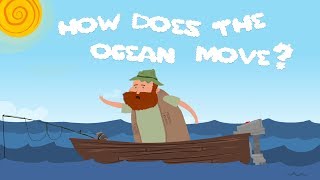(单词翻译:单击)
If you've ever floated on an ocean swell, you'll know that the sea moves constantly.
如果你曾经在海洋上漂浮,你就会知道海水是持续运动的。
Zoom out, and you'll see the larger picture: our Earth, covered by 71 percent water,
放眼整个地球,你就会了解更完整的运动状况:我们地球71%的表面被水覆盖,
moving in one enormous current around the planet.
形成一个巨大的洋流,绕着地球流动。
This intimidating global conveyor belt has many complicated drivers,
这个全球传送带令人叹为观止,其形成因素很多很复杂,
but behind it all is a simple pump that moves water all over the earth.
但我们可以用一个使海水绕地球流动的简单的水泵来概括。
The process is called thermohaline circulation, and it's driven by a basic concept: the concentration gradient.
这个过程叫做热盐环流,形成它的基础概念是浓度梯度。
Let's leave the ocean for one moment and imagine we're in an empty room
让我们先把海洋环境放到一边,想象我们身处一个空房间里,
with lots of Roombas sardined together in one corner.
里面有很多自动吸尘器成堆地挤在一个角落中。
Turn them all on at once and the machines glide outwards
把它们全部启动的话,这些机器就会划向四周,
bumping into and away from each other until the room is filled with an evenly spaced distribution.
互相撞来撞去,直到整个房间都均匀地布满了这些吸尘器。
The machines have moved randomly towards equilibrium,
这些机器的运动方向是随机的,并最终达到平衡,
a place where the concentration of a substance is equally spread out.
也就是在房间各个角落的分布是均匀的。
That's what happens along a concentration gradient,
这就是浓度梯度的原理,
as substances shift passively from a high, or squashed, concentration, to a lower, more comfortable one.
物质会被动地从高密度的地方向低密度、更“舒适”的地方移动。
How does this relate to ocean currents and thermohaline circulation?
而这又与洋流和热盐循环有什么关系呢?
Thermo means temperature, and haline means salt because in the real world scenario of the sea,
“thermo”意思就是温度,而“haline”是盐的意思,因为在现实的海洋中,
temperature and salinity drive the shift from high to low concentrations.
分布不均的温度和盐分促使洋流从高浓度流到到低浓度。
Let's put you back in the ocean to see how this works.
让我们再回到海洋,看看现实情况是怎样的。
Snap! You're transformed into a molecule of surface water,
啪!你变成海面上的一个分子,
off the temperate coast of New York surrounded by a zillion rowdy others.
身处纽约沿岸温和的海面上,周围都是大量闹哄哄的其他分子。
Here, the sun's rays act as an energizer that set you and the other water molecules jostling about,
在这里,太阳的光照提供了能量,使你和其他水分子相互推挤,
bouncing off each other like the Roombas did.
撞来撞去,像自动吸尘器一样。
The more you spread out, the less concentrated the water molecules at the surface become.
你们分布得越广,海面水分子的密度就越低。
Through this passive motion, you move from a high to a lower concentration.
在这个被动过程中,你从高密度区域移动到了低密度的区域。
Let's suspend the laws of physics for a moment,
让我们先暂时忘掉物理定律,
and pretend that your molecular self can plunge deep down into the water column.
假设作为分子的你可以一直潜入到海底深处。
In these colder depths, the comparative lack of solar warmth makes water molecules sluggish,
在寒冷的海底,阳光照射相对较少,水分子活性较低,
meaning they can sit quite still at high concentrations. No jostling here.
也就是说它们在高浓度时也依旧静止不动。不会发生碰撞。
But seeking relief from the cramped conditions they're in,
但它们也想从所在的拥挤环境挣脱出来,
they soon start moving upwards towards the roomier situation at the surface.
于是它们开始向上游动,游向海面更宽敞的地方。
This is how temperature drives a shift of water molecules from high to low concentrations, towards equilibrium.
这就是温度推动水分子流动的方式,它们从高密度流向低密度,最终达到平衡。

But sea water is made up of more than just H2O.
但组成海水的不光有水分子。
There are a great deal of salt ions in it as well.
还有大量的盐离子。
And like you, these guys have a similar desire for spacious real estate.
而像你一样,它们也想要在宽敞的环境中居住。
As the sun warms the sea, some of your fellow water molecules evaporate from the surface,
当太阳光加热海水时,你们中有些水分子从海面蒸发,
increasing the ration of salt to H2O.
增加了水中含盐量的比例。
The crowded salt ions left behind notice that lower down, salt molecules seem to be enjoying more space.
拥挤的盐离子仍然留在水面,并注意到海水深处的盐离子似乎能享受到更多的空间。
And so an invasion begins, as they too move downwards in the water column.
所以它们开始入侵了,它们也向下游到海水深处。
In the polar regions, we see how this small local process effects global movement.
在极地地区,我们可以看到这些微观的过程是如何影响全球环流的。
In the arctic and antarctic, where ice slabs decorate the water's surface,
在南北极,海面布满了浮冰,
there's little temperature difference between surface and deeper waters.
海面与海水深处产生了细微的温差。
It's all pretty cold. But salinity differs, and in this scenario, that's what triggers the action.
其实两边都很冷。但盐分分布不一样,在这种情况下,这种差距促使了反应的发生。
Here, the sun's rays melt surface ice, depositing a new load of water molecules into the sea.
这时,太阳光使部分表面浮冰融化,使一些新的水分子进入海水中。
That not only increases the proximity between you and other water molecules,
这不仅使水分子之间距离更近,
leaving you vying for space again, but it also conversely dilutes the concentration of salt ions.
让你再次想要寻找新的空间,还同时反过来稀释了盐离子的浓度。
So, down you go, riding along the concentration gradient towards more comfortable conditions.
所以你会向下移动,沿着浓度梯度一路往下,向更舒适的环境游去。
For salt ions, however, their lower concentration at the surface,
而对盐离子来说,它们在海面的低浓度
acts like an advertisement to the clamoring masses of salt molecules below who begin their assent.
就像宣传广告一样,吸引着底下大批的盐离子,它们开始蠢蠢欲动。
In both temperate and polar regions, this passive motion along a concentration gradient, can get a current going.
无论是在温带还是在极地,这种沿着浓度梯度的被动过程都促成了洋流活动。
And that is the starting point of the global conveyor called thermohaline circulation.
这就开始了名为热盐环流的全球传送带。
This is how a simple concept becomes the mechanism underlying one of the largest and most important systems on our planet.
这就是一个简单的理论,支撑起了我们地球规模最大以及最重要的系统之一。
And if you look around, you'll see it happening everywhere.
而如果你看看周围,你会发现这种现象无处不在。
Turn on a light, and it's there. Concentration gradients govern the flow of electricity,
开灯也是这个原理。浓度梯度支配着电流的产生,
allowing electrons squashed together in one space to travel to an area of lower concentration
使挤在一块儿的电子向电子密度更低的地方移动,
when a channel is opened, which you do by flipping a switch.
当你打开开关,电流通道也就打开了。
Right now, in fact, there's some gradient action going on inside you as you breath air into your lungs
事实上,现在也有浓度梯度现象发生在你体内,随着你把氧气吸入肺部,
letting the concentrated oxygen in that air move passively out of your lungs and into your blood stream.
肺部堆积的氧气就会被动地排出,进入到血液中。
We know that the world is filled with complex physical problems,
我们都知道,世界充满了复杂的物理问题,
but sometimes the first step towards understanding them can be simple.
但是有时候,理解它们的第一步是很简单的。
So when you confront the magnitude of the ocean's currents,
所以当你遇到像洋流这样宏大的问题,
or have to figure out how electricity works, remember not to panic.
或想要了解电力如何运作时,记住不要慌张。
Understanding can be as simple as flipping a switch.
认识的过程就像打开开关一样简单。


